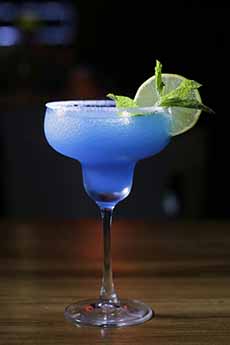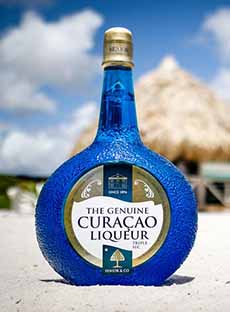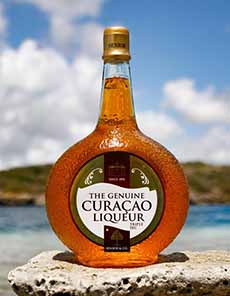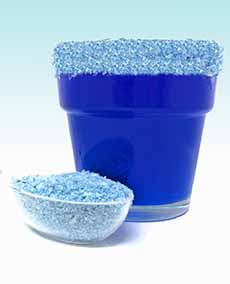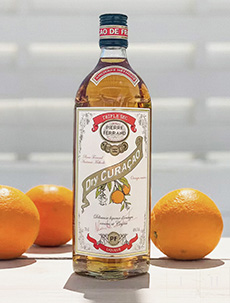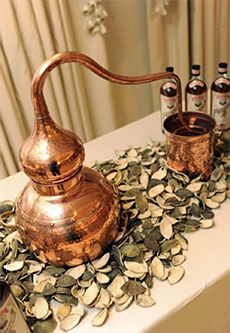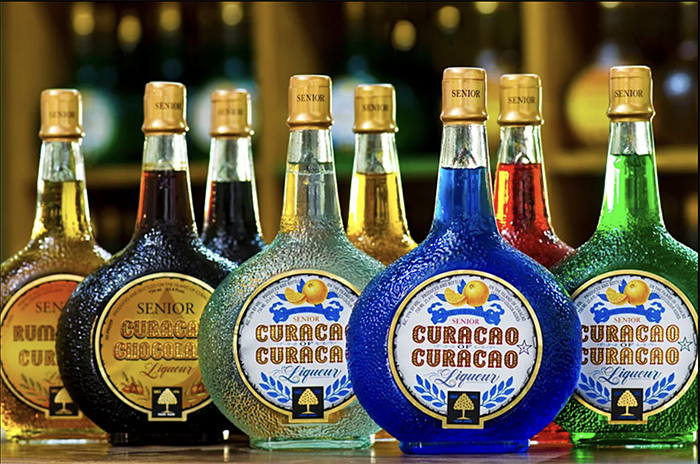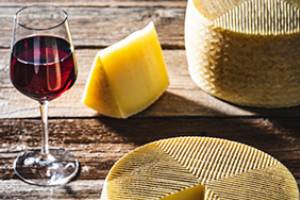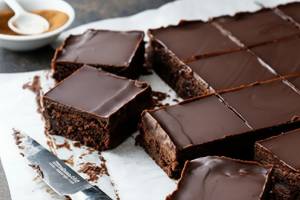A Blue Curaçao Margarita For National Margarita Day
|
|
Blue Curacao is a fun contradiction in terms: an orange-flavored liqueur that’s blue in color. Most orange liqueurs are clear. So for fun on National Margarita Day, February 22nd, how about a Blue Margarita (photo #1)? (Also mark your calendar for Cinco de Mayo and July 24th, National Tequila Day.) The Blue Margarita simply substitutes one type of orange liqueur for another; in this case, Blue Curaçao, a clear liqueur that’s colored bright blue for a more dramatic-looking drink. (See the different types of orange liqueur below). The island’s only distillery, Senior & Co., which produced the first the original Curaçao at the end of the 19th century, also produces four other flavors (photo #9). After Blue (photo #2), the second most popular variety is Orange Curaçao (photo #3). The recipe follows. But first: > The history of Curaçao liqueur is below. > The history of the Margarita. > The history of the Margarita glass. > The history of tequila and the different types of tequila. > The different types of orange liqueur, below. > Throw a Margarita party. Curaçao is an orange liqueur that originated in the Caribbean island of Curaçao. It is used interchangeably with other orange liqueurs. It typically has a slightly more complex flavor profile than generic triple sec from the Caribbean (see the different types of orange liqueurs below) due to the addition of herbs and spices: bitter orange peels, cloves, and orange zest, for example. Triple sec, on the other hand, tends to be more purely orange-flavored and considered drier (less sweet). Both are made by infusing the dried peels of the laraha citrus in alcohol, and then, in the case of Curaçao, adding orange or blue food coloring. The laraha, a descendant of the Valencia orange, is also known as the Curaçao orange or the Golden Orange of Curaçao. The laraha peel (photo #8) is prized for its rich aroma. The liqueur is naturally colorless, and most triple sec producers leave it that way. But in Curaçao, food coloring is added to make it more visually appealing. A Margarita is usually served straight up. For a drink on the rocks, use fresh ice. For a blender drink. add the ingredients into a blender with a cup of ice, and blend until smooth. 1. CREATE the salt rim. Rub the rim of the glass with a wedge of lime and twist it in a dish of rimming salt. 2. COMBINE the tequila, Curaçao, lime juice and simple syrup in a cocktail shaker filled with ice. Shake well and strain into the glass. 3. GARNISH and serve. Curaçao liqueur originates from the Caribbean island of Curaçao, a Dutch territory. In 1499, Spanish explorers arrived and claimed the land for Spain. They planted Valencia orange trees there. But due to the island’s arid climate and poor soil, the oranges that grew were too bitter to eat. The groves were left to grow wild. Curaçao remained under Spanish control for more than a century. The Dutch West India Company seized the island in 1634. Over time, locals noticed that the inedible fruits released a fragrant citrus aroma. In 1896 European family living on the island, the Seniors, began experimenting with the peels by steeping them in alcohol. This led to the creation of Genuine Curaçao Liqueur by the Senior & Co. distillery, which still operates today. Today, Senior & Co. makes five colors of orange liqueur—and three other flavored liqueurs, Chocolate, Coffee and Rum Raisin (photo #9). Note that the name Curaçao is not trademarked and is not required to be made on the island of Curaçao. In fact, Senior & Co. is the only producer on the island. The native bitter orange was classified as Citrus × aurantium var. currassuviensis. The word laraha is derived from the local Papiamentu language and is believed to be a modification of the Spanish word naranja, which means orange. Other European distilleries followed suit, developing their own versions of orange liqueur. Over time, Curaçao evolved into different styles (below), most of them the naturally clear version but also the now-famous blue and orange-colored varieties. While original Curaçao is naturally clear, colored versions use food-grade dyes. By the way, the island of Curaçao is still a Dutch territory, but in 2010, it became a separate autonomous country within the Kingdom of the Netherlands after the dissolution of the Netherlands Antilles. It’s a Parliamentary democracy. Thus, Curaçao governs its own internal affairs (e.g., local laws, economy, and government), while the Dutch government oversees defense, foreign policy, and some judicial matters. And the name of the island? Nobody knows its origin. Cointreau, Curaçao, Gran Gala, Grand Marnier, triple sec (the latter a generic name, not a brand): All of these are orange liqueurs and can be used interchangeably. Orange liqueur comes in three main categories, primarily categorized by production method and flavor profile. Here they are, with some popular brands. Triple sec is a clear, dry, spirit-based orange-flavored liqueur. It has a crisp, dry, and slightly sweet citrus flavor. Popular brands: |
|
|
Curaçao Orange Liqueur Curaçao is a sweeter, often brightly-colored liqueur from the Caribbean island of Curaçao. It’s made from the dried peels of the laraha citrus, a bitter orange native to Curaçao. Popular brands: Grand Marnier is a high-end blend of Cognac and orange liqueur, made by blending Cognac with bitter orange essence. It has a richer, more complex flavor profile than liqueurs in the other categories, including a notes of vanilla/caramel. It is made in different versions: All three are 40% A.B.V. (alcohol by volume), or 80 proof. 1. Cointreau (Triple Sec category) is used in classic cocktails like the Cosmopolitan, Margarita, and Sidecar. 2. Grand Marnier (Cognac-Based category) is a premium brand that is ideal for sipping neat, for Margaritas, and desserts like Crêpes Suzette. 3. Pierre Ferrand Dry Curaçao (Cognac and Curaçao categories), is considered perfect for Mai Tais, Old Fashioneds, and other sophisticated cocktails. CHECK OUT WHAT’S HAPPENING ON OUR HOME PAGE, THENIBBLE.COM.
|
||
